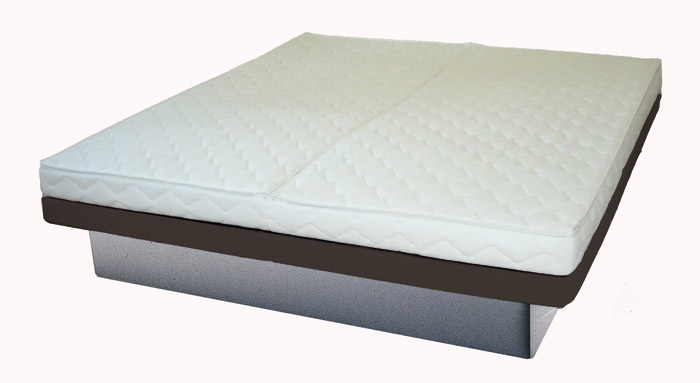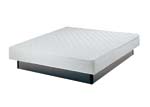Plastics and Composites for manufacturing waterbed foils
Plastics are materials that are derived from synthetic polymers. "Polymer" comes from the combination of the Greek words "poly", which means many, and "meros", which means parts. Therefore, a polymer is a very long molecule (macromolecule) that is made-up of many repeating parts that are usually referred to äs "mers". Similarly, an oligomer is a molecule made up of a small number of mers (typically ten). For example, consider a macromolecule of polyethylene. Ethylene gas molecules are the monomers that are linked together to form oligomeric ethylene and polyethylene molecules.It is possible to create a variety of polymers by changing the mer group. It is also possible to have molecules with different bonds between the carbon atoms on the backbone of the chain (like double and triple bonds) äs well äs other atoms or chemical groups instead of some of the carbons. Copolymers have more than one type of mer group in the molecules; for example AB S molecules have acrylonitrile, butadiene, and styrene mer groups linked together to form a long molecule. Therefore, the number and types of polymers are almost endless.
Polymers are divided into two major groups: thermosets and thermoplastics. As the names imply, thermosets are thermally set to their final geometry while thermoplastics can be thermally heated to enable reforming or reshaping. A long polymer molecule, which is also referred to äs chain, has mer groups linked together by pnmary chemical bonds like the carbon-carbon bond for polyethylene.
Thermoplastics are made up of many polymer chains that are held together by weak secondary chemical bonds. Therefore, when a thermoplastic is heated, the weak secondary bonds between molecules are broken and the molecules can slide relative to each other allowing the polymer to be reshaped.
For a thermoset, the long polymer chains are held together by primary chemical bonds called cross-links. Therefore, after the chemical reaction that forms the cross-links is completed, reheatmg cannot break these bonds without also breaking the carbon-carbon bonds with the chain; at that point, chains break into smaller Segments resulting in degradation. Thermosets can also be created by branching (see Fig. 1.4). For welding or fusion bonding, it is desirable to enable molecules to diffuse across the weld interface without degradation. Therefore, welding or fusion bonding of thermosets is not possible except in rare instances where cross-links can be broken without degradation.
Thermoplastic molecules are held together by secondary chemical bonds, which can be broken by heating. This permits thermoplastic molecules to slide relative to each other and to diffuse across a weld interface. Therefore, thermoplastics can be welded. As shown in Fig. 1.3, thermoplastics can also be divided into two groups: amorphous and semi-crystalline. Amorphous thermoplastics have long molecules that are coiled, kinked, or have large side groups so that they are randomly intertwined without any order or structure. Semi-crystalline thermoplastics have long linear molecules forming highly ordered and compact structures in the form of crystallites. However, these very long molecules cannot form highly ordered structures throughout, resulting in some amorphous regions in the material, hence the name semi-crystalline.
Amorphous polymers behave like glassy solids below a temperature known äs the glass transition temperature (Tg). Above the glass transition temperature, an amorphous polymer softens, permitting reshaping. While semi-crystalline polymers also have a glass transition temperature, they also have a melting temperature (Tm), denoting the point where the crystallites melt. Therefore, many semi-crystalline polymers can be used in structural applica-tions at temperatures above the glass transition temperature, so long äs the temperature is kept below the melting temperature. For example, for HDPE the glass transition tempera-ture is at about -120 °C, but it provides useful solid properties to temperatures in excess of 75 °C. Figure 1.5 shows that the viscoelastic modulus of an amorphous polymer drops rapidly above T For a semi-crystalline, the viscoelastic modulus drops slightly above Tg, with a much larger drop above Tm.
Composites are materials that consist of two or more distinct materials or parts. These may include polymers with one or more types of fibers and particulates. Organic and inorganic fibers can be in the form of continuous fibers, long fibers, or short fibers and they can have specific alignment or orientation or they can have random orientation. The particulates can also be organic or inorganic in the form of spheres, plates, ellipsoids, hollow and solid particles. Therefore, the combination of a large variety of polymers with many types of fibers or particulates can result in an almost endless list of composites. The chemical, mechanical, and optical properties of all polymers can be changed greatly through additives, which in addition to reinforcements may also include plasticizers, flame retardants, or colorants. These changes in chemical, physical, and mechanical properties can have an important impact on joining aspects.Classification of Welding Processes.
Joining of Plastics and Composites for manufacturing a waterbed or Watermattress
Welding a special Waterbed-PVC-Foil to manufacture the watermattress.
Process Description of welding a waterbed or watermattress with Radio Frequency
Waterbed-Foils: Plastics and Composites for manufacturing waterbed foilsWaterbed Manufacturer ChinaBecause we manufacture the Waterbeds in China, we can offer you cheap prices for every article made of vinyl or foam. We are cheaper than some other waterbed factories in China or whole Asia, but we surely are not the cheapest waterbed manufacturer worldwide. Even if you buy our cheapest Waterbeds we try to do works like welding and cutting of the vinyl the best as we can and we have a long time knowledge in manufacturing waterbeds. We can manufacture waterbeds with the most durable foils produced by BAYER AG from Germany. ----------------------------------------------------------------------------------------------------------------------- |
|
| ------------------------------------------------------------------------------------------------------ |
|
| ------------------------------------------------------------------------------------------------------ |
Here you
will see the detailed description of the Waterbed / Watermattress articles
like Foam Rails, Mattress Covers, Waterbags and Liners, Waterbed Heaters. |
waterbed producer and manufacturer watermattress or waterbed mattress




